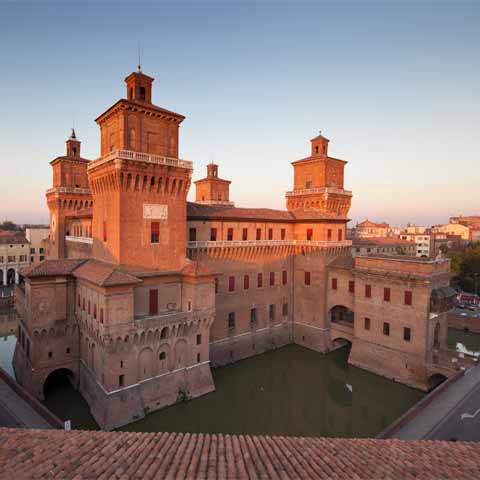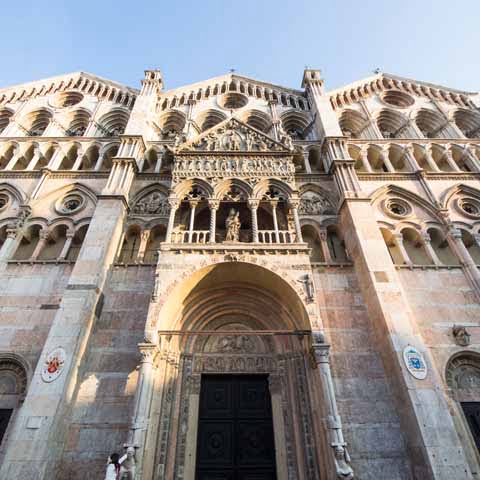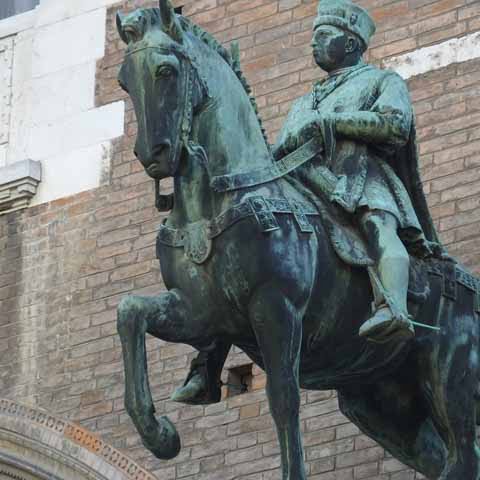Ferrara is a picturesque city located on the left bank of the Po River in the Emilia-Romagna region of Northern Italy. Burana canal also crosses the city, and the urban structure has been characterized since the twelfth century AD by a busy network of roads converging towards the main square, where the market was established.
Due to its commercial importance, Ferrara enjoyed its first urban extension outside the city walls in the fourteenth century, in parallel with the erection of the Este Castle.
The impressive urban planning which earned Ferrara the nickname of the “First Modern City in Europe” and the “City of the Renaissance” continued in the second half of the century. In the fifteenth century, the Este dynasty brought wealth to the city and contributed to the development of the settlement by building the Erculea district, commissioned by Ercole I d’Este and supervised by the architect Biagio Rossetti.
Erculea doubled the urban area and gave Ferrara an imposing and solemn appearance. The urban development involved the widening of the streets, while symmetrical buildings emerged interspersed with green spaces.
The urban development continued throughout the centuries, and in the nineteenth century, this amazing city of the Renaissance incorporated the mesmerizing villages of San Luca, Porta Mare, San Giorgio, and Quacchio.
Progressively, the urban agglomeration extended along the main rail and road routes towards the northwest. Slowly, but steadily, Ferrara continued its development throughout the whole twentieth century and became an important industrial center.
Besides its industries, Ferrara also boasts an established university and is a renowned archiepiscopal seat. Today, Ferrara attracts international travelers interested in experiencing its vast wealth of cultural monuments.
PREHISTORY OF FERRARA
The origins of Ferrara are covered in mystery, but it is certain that the name of the city dates from medieval times. According to local legends, Ferrara was a young lady who fled from Troy and decided to found a settlement in her name.
Whether the legend is true or not, archaeological evidence suggests the first urban settlement in the area dates back to the Bronze Age. According to some scholars, the city may have been founded by the Pelasgians, the ancestors of the Greeks.
In fact, in the sixth century BC, the Spina area was a thriving commercial port that linked Central Italy with Greece.
The passage of the Gallic peoples is also attested by evidence of the era, while remains of the Roman settlement are scattered throughout the city center, concentrated mainly in the current area of San Nicolò, San Giorgio, and in the boroughs of Voghiera and Voghenza.
Eventually, the Romans instituted Ducatus Ferrariae along the Po River and the settlement developed in two distinct nuclei that were hardly connected, neither topographically or chronologically.
The first center was built in the seventh century AD around the old Cathedral of San Giorgio, at the confluence of the two rivers that stretch through the city and probably emerged as a consequence of the decadence of the bishop’s seat in Voghenza. The second center was the Byzantine Castrum built on the opposite bank of the Po River and probably emerged as a fortified military settlement.
HISTORY OF FERRARA
In the eighth century, Ferrara passed under the dominion of the Longobards, as it appears in the first historical document of King Alfonso, in which the king describes his dominion over the city. The whole Ducatus Ferrariae passed under the control of Ravenna, and in 774 was ceded by Charlemagne to the papacy.
Although the papacy assigned the administration of the territory to the Archbishop of Ravenna, Ferrara managed to claim an autonomous order in 988. As a result, Pope John XV appointed the feudal lord Marquis Tedaldo di Canossa as a ruler.
However, the city always maintained a liberal government, and the locals often came into conflict with the Marquis and his descendants. In a short time, things escalated to the point that in 1101, Matilde di Canossa had to resort to the use of weapons to reclaim power over the city, leaving administrative control to a municipality governed by captains and consuls elected annually by the inhabitants.
The second half of the tenth century saw Ferrara struggling in the battle for supremacy between the Guelph and the Ghibelline factions. The struggles ended in 1158 when the Imperial troops occupied the city; power passed to Federico Barbarossa, but the families interested in supremacy over the city did not accept the defeat.
Struggles resumed, and in 1164 Guglielmo II Adelardi claimed supremacy over the city. At his death, the territory was inherited by Guglielmo’s niece, the wife of Azzo VI d’Este. But the struggles did not cease as the Ghibellines were still interested in the territory.
In the end, d’Este managed to reach an agreement with Salinguerra and formed a common government that lasted until 1222, the year in which Salinguerra claimed the title of lord of the city.
However, the dream of the glory of the Salinguerra did not last long, and after merely twenty years the Guelph coalition led by Azzo VII defeated the Ghibellines and claimed lordship over Ferrara. From this moment on, the power of the Este would shape the future of the city.
Azzo VII was succeeded by his nephew Obizzo di Rinaldo, a figure remembered as the perpetual lord of the city. Obizzo began a government action designed to expand the power of the lordship, during which the mayor of Ferrara and the other municipal magistracies became subject to a despotic power.
The Este family gave a strong feudal imprint to their domains, focusing mainly on agricultural production and not necessarily on infrastructure and traffic.
During Obizzo’s lordship, however, Ferrara saw expansive growth and incorporated the nearby cities of Modena and Reggio.
In 1293, power was assumed by Azzo III who continued the policy of his predecessor and started a war against Bologna in an attempt to extend Ferrara’s supremacy over new territories. Pope Boniface VIII intervened and put an end to the struggles, but the events drew the attention of the Papal State and Venice.
The beginning of the fourteenth century found Ferrara fighting against the expansionist ambitions of the Holy State and the Venetian Republic; Pope Clement V sent his troops to assume power, but in a twist of events the Venetian Republic decided to help Ferrara under the promise that the city would become their dominion.
As a result, Ferrara passed under Venetian rule, but after suffering a defeat on other fronts, Venice decided to abandon Ferrara only a year later.
This left the city at the mercy of the Papal State. What followed was a series of struggles and battles of the locals against the Pontifical vicar Robert of Anjou. Following his victory, Anjou proclaimed Obizzo III, Nicolò I, Azzo d’Este, and Bertoldo d’Este as lords of the city.
During the second half of the fourteenth century, the Este, following numerous negotiations, succeeded in obtaining their official investiture as Lords of the city from the Papal State.
From this moment on, the history of the city would be forever linked to the history of the Este, who contributed to make Ferrara a city rich in culture and monuments. Their rule made the city a reference point for nearby settlements from an innovative point of view.
In fact, while banking and credit activity was mainly carried out by a Jewish colony who found particularly favorable conditions in Ferrara, the Este concentrated on the development of art and culture. Thanks to their rule, Ferrara became one of the main centers of the Renaissance during the fifteenth and sixteenth centuries.
The beginning of this great cultural development was marked by the founding of the University in 1391, followed by important investments in architecture, culture, and arts that brought Ferrara to the highest European levels.
During the whole Renaissance period, Ferrara became a destination for humanists and men of arts, such as Battista Guarini, Leon Battista Alberti, Piero della Francesca, Rogier van der Weyden, Pisanello, and Titian. The local school, called Officina Ferrarese, also attracted numerous musicians, writers, and poets, many of whom settled to work for the dukes of Ferrara.
An important figure of the era was Duke Borso d’Este, who expanded the city walls and built numerous Este villas.
But the golden age of Ferrara began under Ercole I, who contributed to the expansion of the city; many monuments and buildings from the Renaissance period are, in fact, linked to his name. His successor, Ercole II, became the promoter of peace between Ferrara and the Papal States, but his reign also marked the end of Ferrara’s glory.
The dominion of Alfonso II marked the beginning of the decline of Ferrara and of the power of Este that culminated with the lordship of Cesare d’Este in 1598. In fact, Cesare d’Este abandoned Ferrara definitively in January 1598, handing the role of ruler to Pietro Aldobrandini, a cardinal under Pope Clement VIII.
For the following three centuries, Ferrara was governed by cardinals, and the government of the Church had negative effects not only on the city, but on the surrounding countryside too.
Due to the lack of an interested administration, the territory became impoverished and swampy, while the city experienced an overall decline. But despite the negative judgment of the cardinal administration, academies and schools culturally enriched Ferrara even during this time. This drew the attention of many quality artists who continued to contribute to the city’s cultural heritage.
In 1796, Ferrara was occupied by the French troops and was later annexed to the Cisalpine Republic. From 1799 to 1801, the territory passed under Austrian rule, then the French reassumed their role only to sell the territory to the Church in 1815, as stipulated by the Treaty of Vienna – although Austria continued to maintain a military garrison in the city.
During Napoleonic rule, many of the artworks were removed from the city and never returned. Moreover, the different religious orders caused suppression. The Austrian and French dominations ended definitively in 1859, after years of military revolutions and repressions.
In 1860, Ferrara was annexed to Italy. The unification shook up the old commercial relations between Ferrara and the countryside, favoring the penetration of capitalism and the formation of a class of laborers who followed the socialist propaganda, giving rise to strikes and agitations.
Many of these laborers actively participated in World War I motivated by the promise of receiving arable land. But the unfulfilled promises caused many of the laborers to join the fascist movement following the war.
World War II was marked by Nazi-fascist persecutions against Ferrara’s large Jewish community. Ferrara suffered notable damage due to harsh bombings that destroyed many monuments, including the three synagogues.
The post-war period was fruitful for industrial development and the city experienced a rapid economic growth that favored the establishment of mechanical and chemical industries. New road connections included Ferrara in a network of Italian and European circuits, while the protection and enhancement of the historic center became the main objective of the municipal government.
This led to a reaffirmation of Ferrara’s privileged position as a city of arts and culture, and in 1995 its historic center was declared a UNESCO World Heritage Site.
ARCHAEOLOGY IN FERRARA
With a rather recent history, Ferrara does not boast exceptional archaeological sites. A noteworthy open-air site in the province is the Necropolis of Voghenza, dating between the first and third centuries AD. These burial spots were rich in Roman testimonies, including pottery, coins, oil lamps, and amber artifacts.
Santa Maria di Padovetere is another important archaeological site located in the Province of Ferrara. This early Christian church is an important landmark.
Archaeological artifacts from the Bronze Age and other testimonies of the origins of the city are exhibited in the National
Archaeological Museum of Ferrara. The Piero Leonardi Museum of Paleontology and Prehistory is another noteworthy place that holds evidence of the early humanoid civilizations in the territory.
Apart from these, Ferrara boasts numerous art museums, an impressive castle and splendid architecture dating from the fifteenth century.
Travel Guides
The Emilia Romagna Region of Italy
The Cities of Emilia Romagna, Italy











